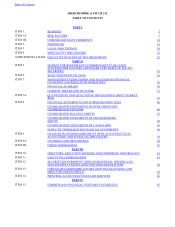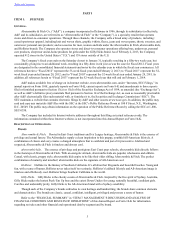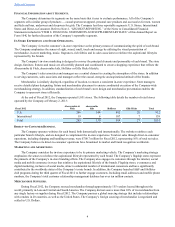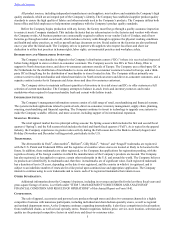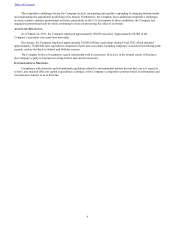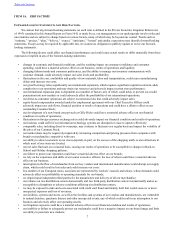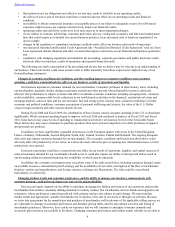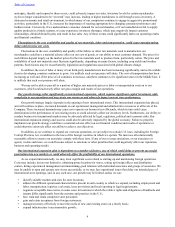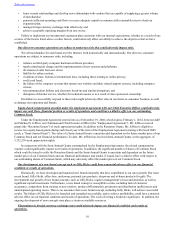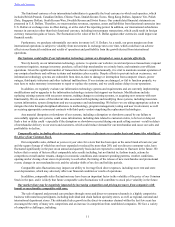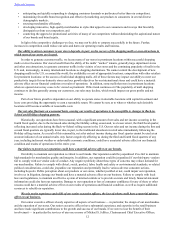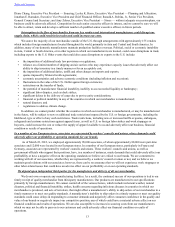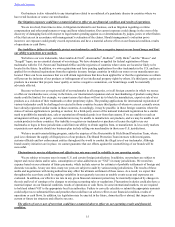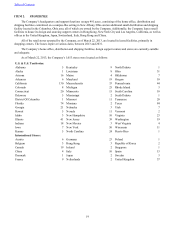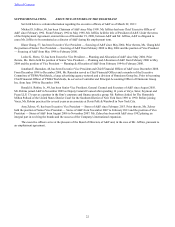Abercrombie & Fitch 2013 Annual Report Download - page 12
Download and view the complete annual report
Please find page 12 of the 2013 Abercrombie & Fitch annual report below. You can navigate through the pages in the report by either clicking on the pages listed below, or by using the keyword search tool below to find specific information within the annual report.
12
• anticipating and quickly responding to changing consumer demands or preferences better than our competitors;
• maintaining favorable brand recognition and effectively marketing our products to consumers in several diverse
demographic markets;
• sourcing merchandise efficiently;
• developing innovative, high-quality merchandise in styles that appeal to our consumers and in ways that favorably
distinguish us from our competitors; and
• countering the aggressive promotional activities of many of our competitors without diminishing the aspirational nature
of our brands and brand equity.
In light of the competitive challenges we face, we may not be able to compete successfully in the future. Further,
increases in competition could reduce our sales and harm our operating results and business.
Our ability to attract customers to our stores depends, in part, on the success of the shopping malls or area attractions in
which most of our stores are located.
In order to generate customer traffic, we locate many of our stores in prominent locations within successful shopping
malls or street locations. Our stores benefit from the ability of the malls’ “anchor” tenants, generally large department stores
and other area attractions, to generate consumer traffic in the vicinity of our stores and the continuing popularity of malls in the
U.S. and, increasingly, in many international locations as shopping destinations. We cannot control the development of new
shopping malls in the U.S. or around the world; the availability or cost of appropriate locations; competition with other retailers
for prominent locations; or the success of individual shopping malls. All of these factors may impact our ability to meet our
productivity targets for our domestic stores and our growth objectives for our international stores and could have a material
adverse effect on our financial condition or results of operations. In addition, some malls that were in prominent locations
when we opened stores may cease to be viewed as prominent. If this trend continues or if the popularity of mall shopping
continues to decline generally among our customers, our sales may decline, which would impact our gross profits and net
income.
Part of our future growth is dependent on our ability to operate stores in desirable locations with capital investment and
lease costs providing the opportunity to earn a reasonable return. We cannot be sure as to when or whether such desirable
locations will become available at reasonable costs.
Our net sales fluctuate on a seasonal basis, causing our results of operations to be susceptible to changes in Back-to-
School and Holiday shopping patterns.
Historically, our operations have been seasonal, with a significant amount of net sales and net income occurring in the
fourth fiscal quarter, due to the increased sales during the Holiday selling season and, to a lesser extent, the third fiscal quarter,
reflecting increased sales during the Back-to-School selling season in the U.S. Our net sales and net income during the first and
second fiscal quarters are typically lower due, in part, to the traditional slowdown in retail sales immediately following the
Holiday selling season. As a result of this seasonality, net sales and net income during any fiscal quarter cannot be used as an
accurate indicator of our annual results. Any factors negatively affecting us during the third and fourth fiscal quarters of any
year, including inclement weather or unfavorable economic conditions, could have a material adverse effect on our financial
condition and results of operations for the entire year.
Our failure to protect our reputation could have a material adverse effect on our brands.
Our ability to maintain our reputation is critical to our brands. Our reputation could be jeopardized if we fail to maintain
high standards for merchandise quality and integrity. In addition, our reputation could be jeopardized if our third-party vendors
fail to comply with our vendor code of conduct. Any negative publicity about these types of concerns may reduce demand for
our merchandise. Failure to comply with ethical, social, product, labor, health and safety or environmental standards, or related
political considerations, could also jeopardize our reputation and potentially lead to various adverse consumer actions,
including boycotts. Public perception about our products or our stores, whether justified or not, could impair our reputation,
involve us in litigation, damage our brands and have a material adverse effect on our business. Failure to comply with local
laws and regulations, to maintain an effective system of internal controls or to provide accurate and timely financial statement
information could also hurt our reputation. Damage to our reputation or loss of consumer confidence for any of these or other
reasons could have a material adverse effect on our results of operations and financial condition, as well as require additional
resources to rebuild our reputation.
We rely on the experience and skills of our senior executive officers, the loss of whom could have a material adverse
effect on our business.
Our senior executive officers closely supervise all aspects of our business — in particular, the design of our merchandise
and the operation of our stores. Our senior executive officers have substantial experience and expertise in the retail business
and have made significant contributions to the growth and success of our brands. If we were to lose the benefit of their
involvement — in particular the services of any one or more of Michael S. Jeffries, Chairman and Chief Executive Officer;
Table of Contents


